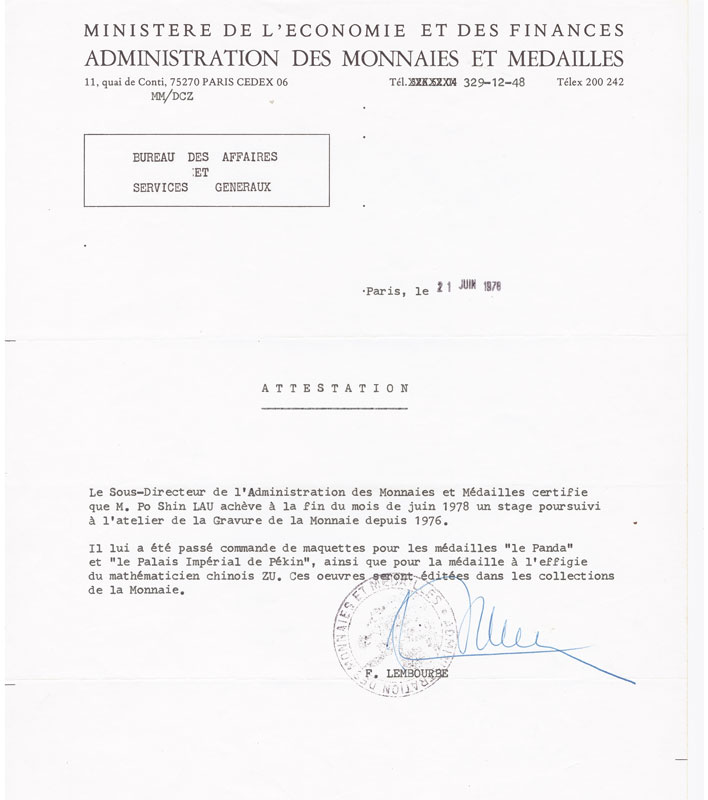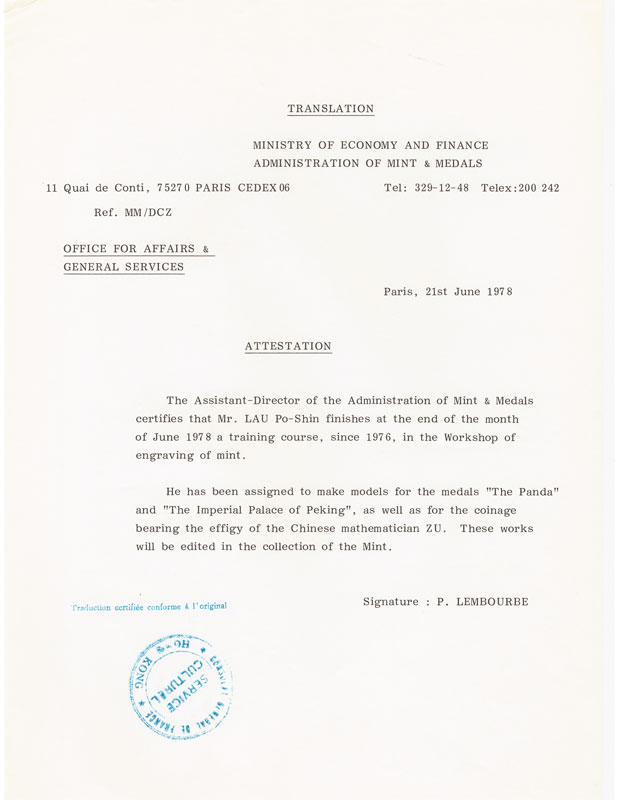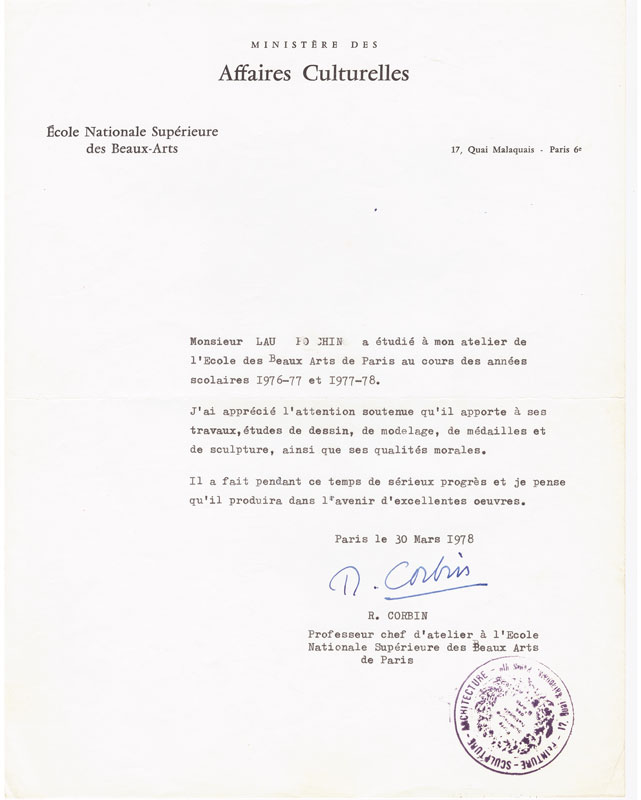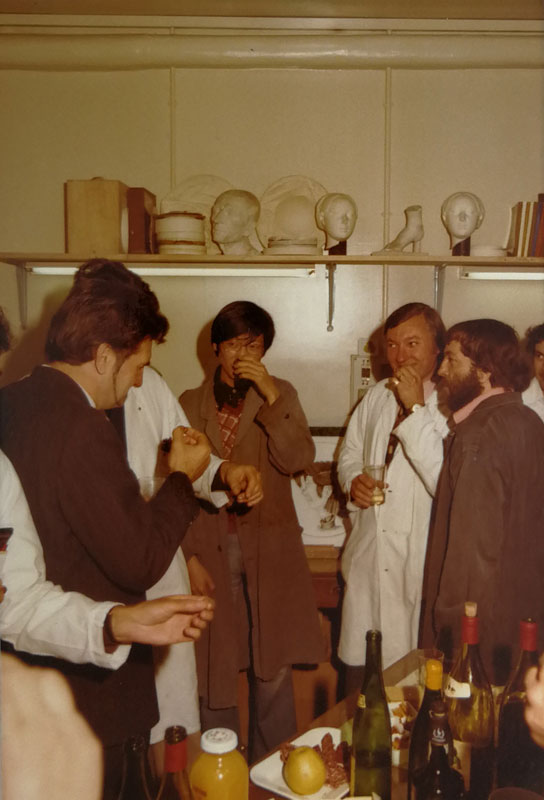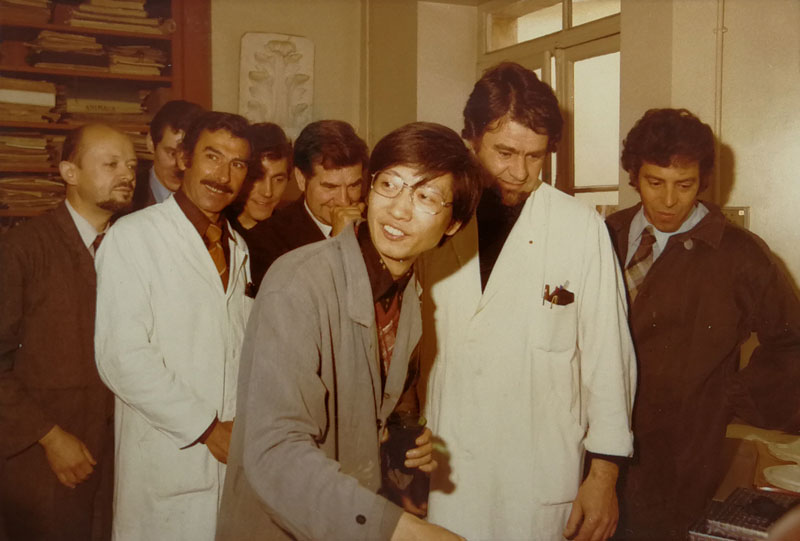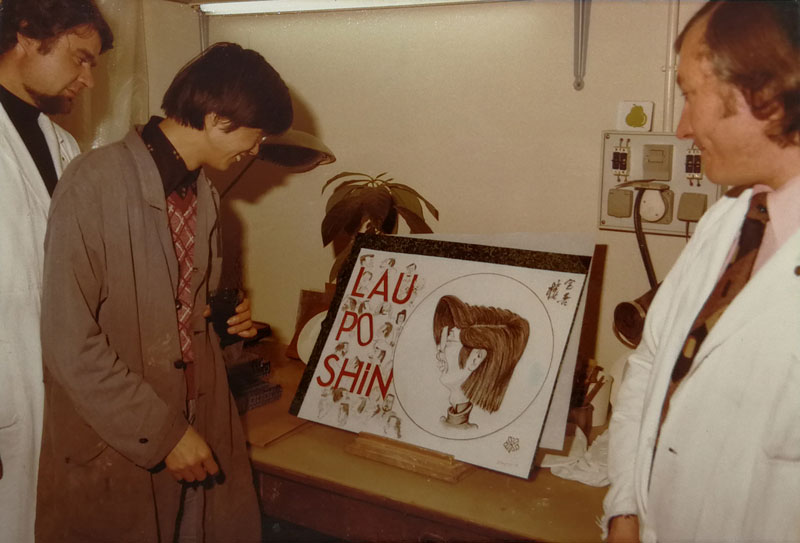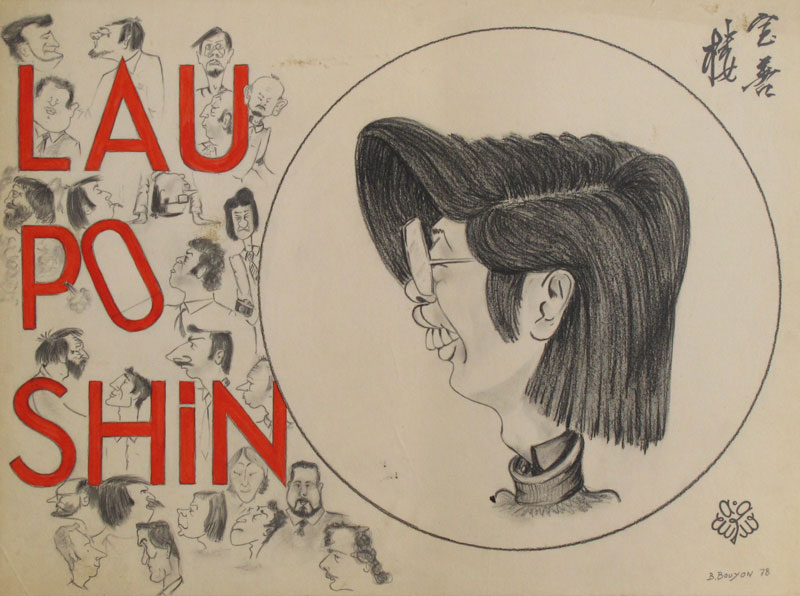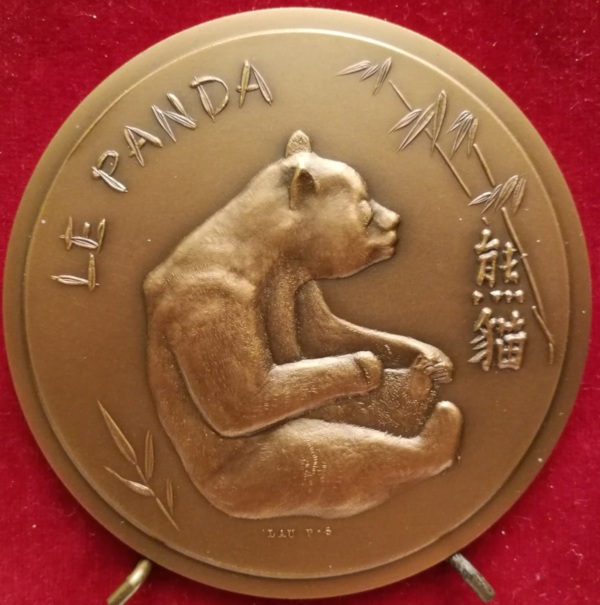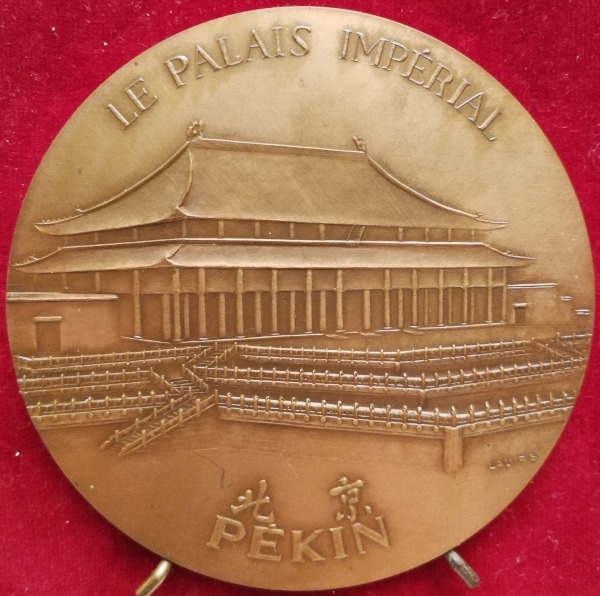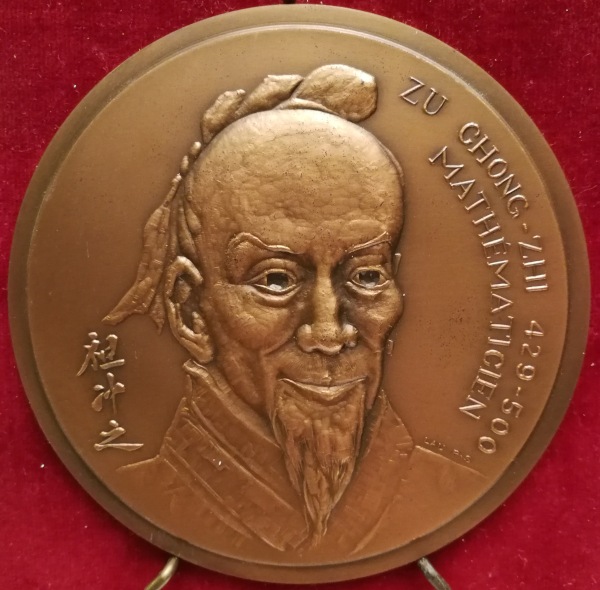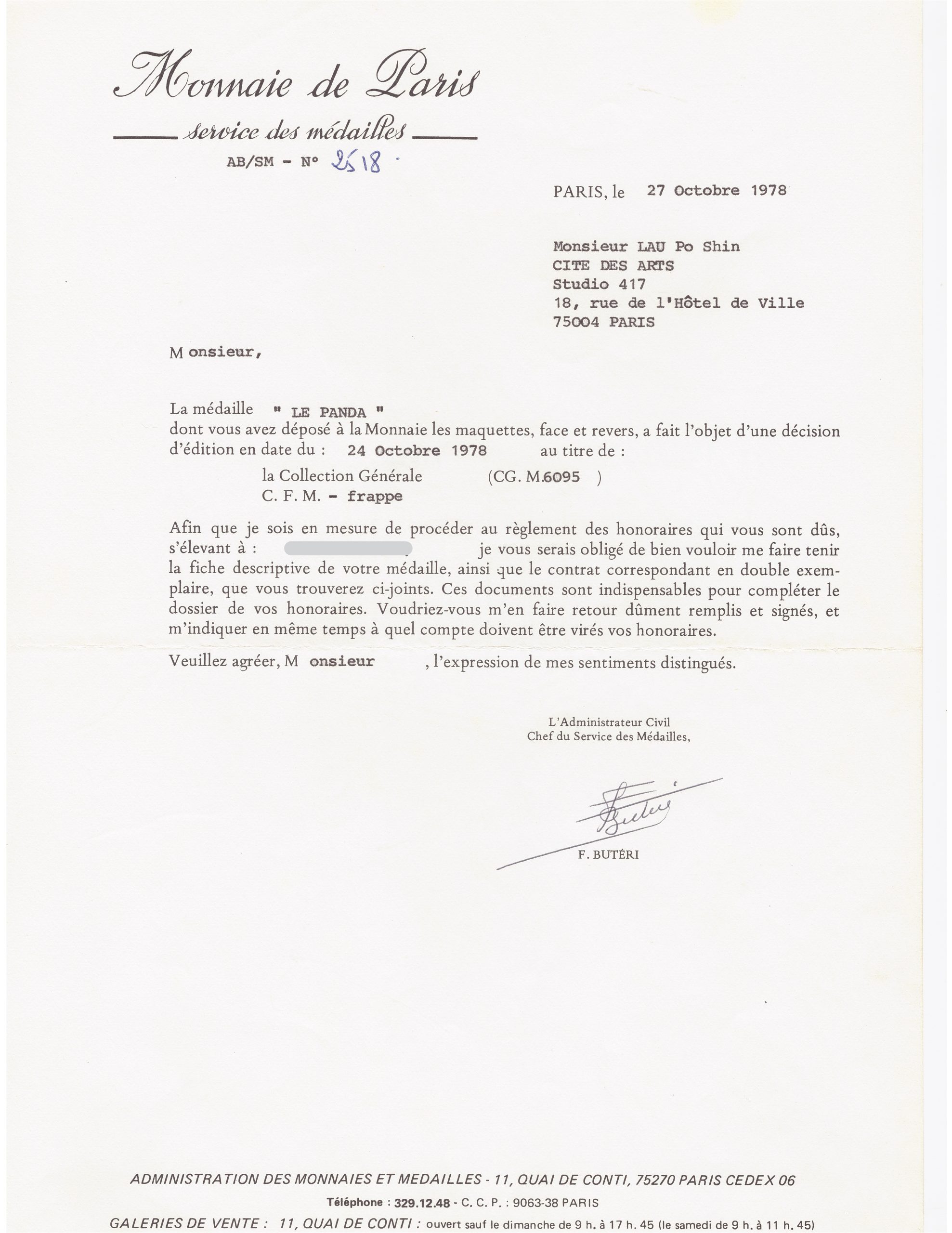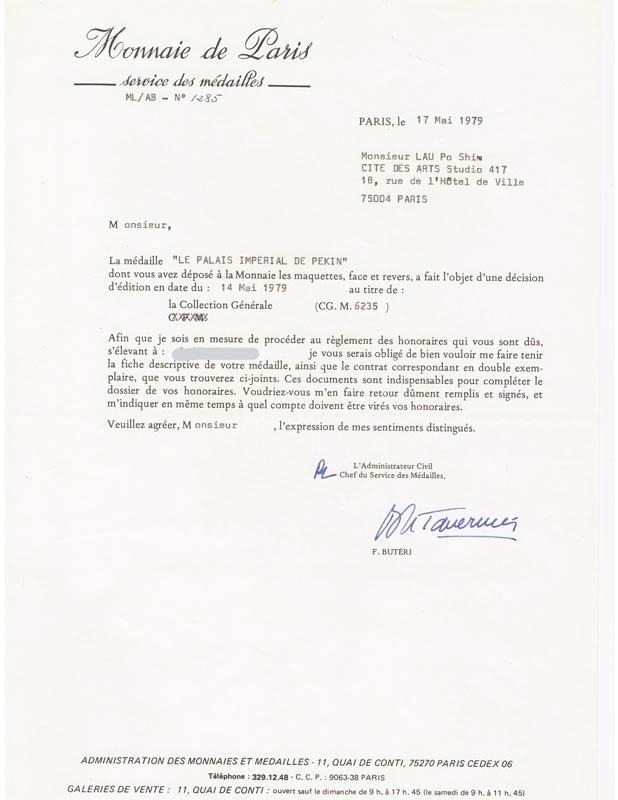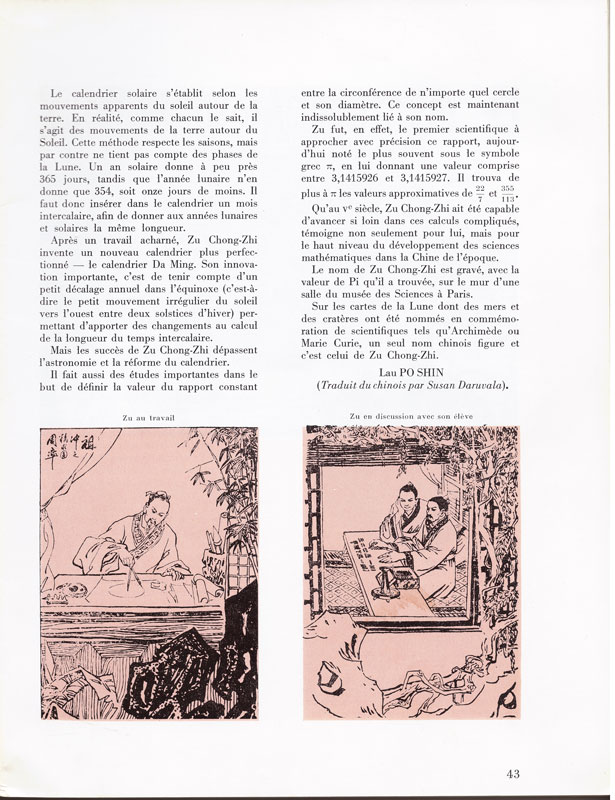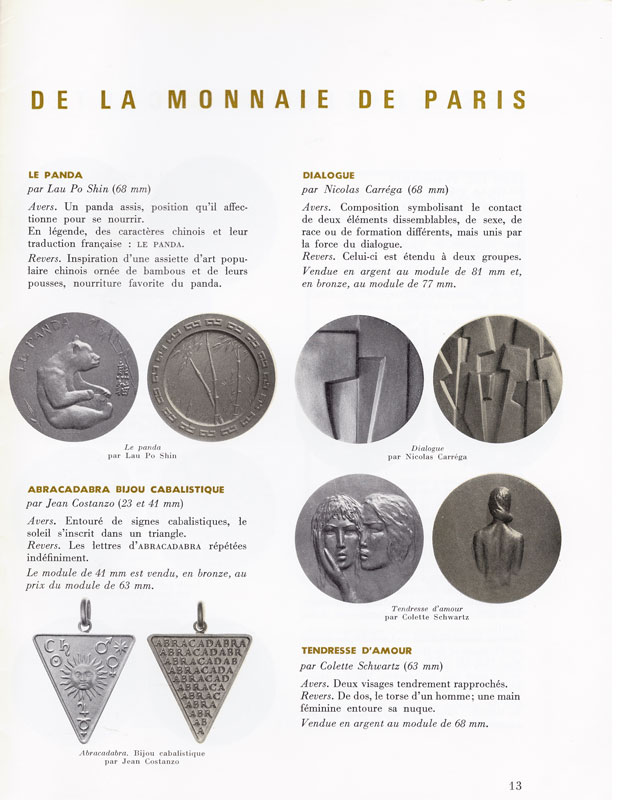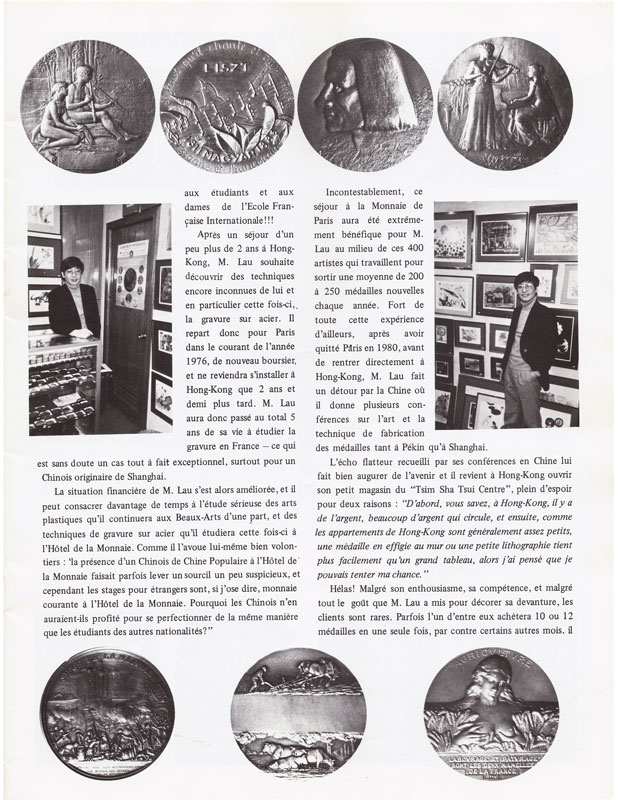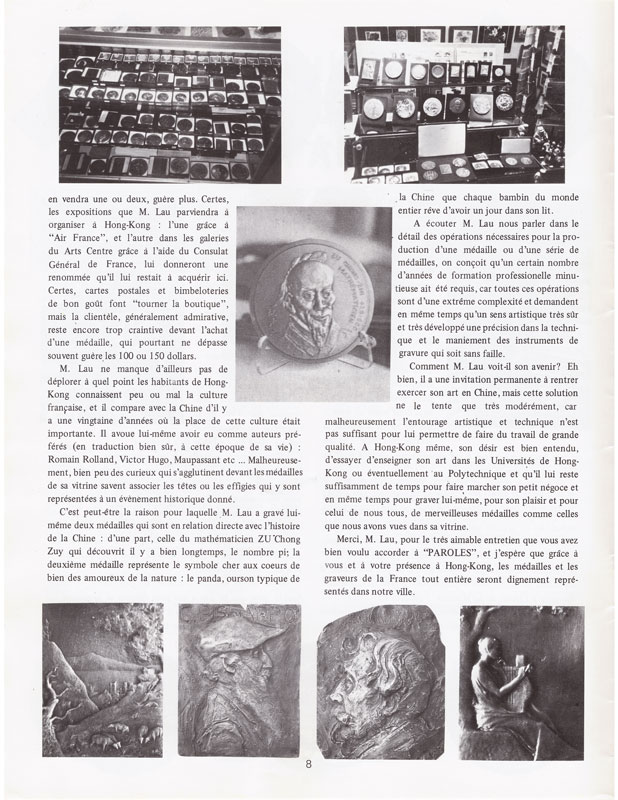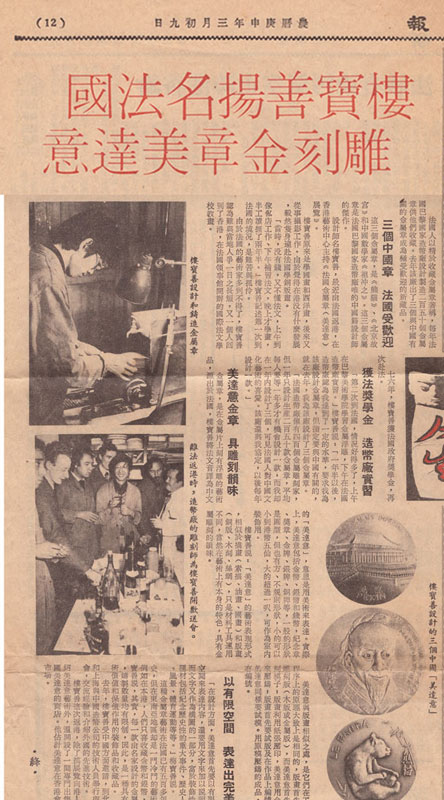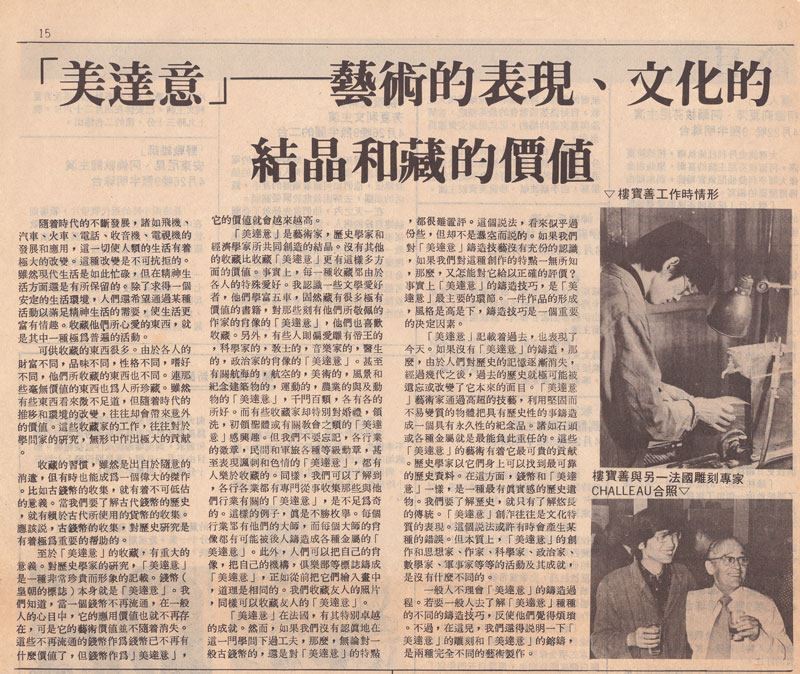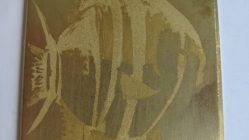Author: Lau Po Shin (樓寶善, 楼宝善) Translation in English by: Karen Yu
Engraving workshop at the Monnaie de Paris. 1976 to 1979.
From 1976 to 1979, I worked and studied at the Monnaie de Paris in France, thanks to a scholarship granted to me by the French Ministry of Foreign Affairs. Besides the production of ordinary coins, the Monnaie de Paris mainly publishes medals for collectors and gold and silver coins. My goal was to learn the technique of hand carving steel molds. So I spent two and a half years with French engravers in the engraving workshop. During this time, I really got to know the life of the French. It also greatly contributed to improving my French skills.
La Monnaie de Paris is a magnificent historic building located on the Seine. We can say that it is the center of Paris. On both sides of the Seine stands the famous Notre-Dame Cathedral, the Louvre, the French Academy and the Academy of Fine Arts of Paris.
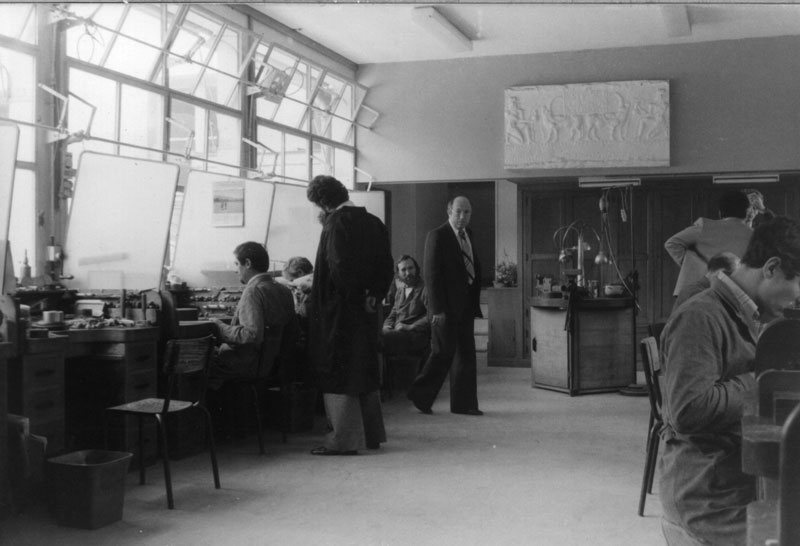
Under the direction of the administration of the Monnaie de Paris, the first person I met was Mister Émile Rousseau, a nice man, who was the general engraver of coins and lived at the Monnaie de Paris in a large house with a old style French room exclusively for him. He once invited me to his house for dinner, and his wife cooked me home-style French dishes. He introduced me to the engravers of the workshop. The workshop has been set up for the profession of an engraver, so there are windows on both sides to the east and west. There is a lot of light from morning to night. Inside, there were workbenches neatly lined up. Upstairs, several steps northeast of the cutting room, there was a room which is under the responsibility of an engraver named Bernard Bouyon. To the south-east of the engraving room, there was a small office which belonged to Pierre Rodier, the master engraver of the engraving workshop. He organizes and directs the daily work operations. By name, he’s my teacher. My office is to the west of that of Master Rodier, located a little further from the other engravers. But in fact, every engraver in the workshop is like my teacher. If you ask them for advice on technical issues, they are very happy to help. There are three master engravers in the engraving workshop. In addition to Pierre Rodier, there are Claude Lesot and Jacki Mauviel. Their status is higher than that of ordinary engravers. In their work, they technically assist Pierre Rodier in the management of the engraving workshop.
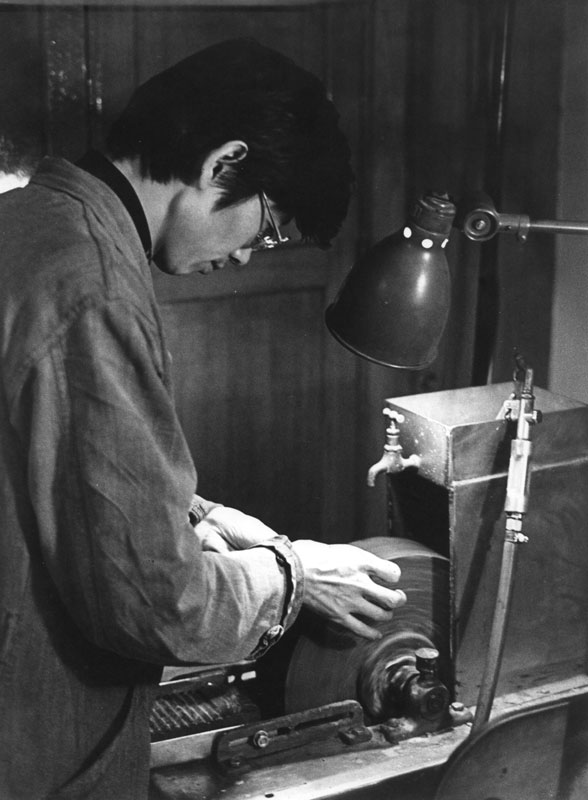
First of all, I had to learn how to make carving knives. I was trained by Madame Rodier’s brother, the engraver, Sylvain Bret. It was very hard work. Square steel bars are high temperature forged into different knife shapes. Then they are processed with a file until they are polished with a sand wheel to form a formal carving knife. It was not easy. It took me a full week to master this basic technique for the first time. I used to work as a fitter in a machine factory in Nanchang, China, so using hammers and files is basically not a big deal or a lack of skill, so after several practices I quickly mastered it. Sylvain and his wife Colette were the first to invite me to their home.
Among the twenty or so engravers, there was a Frenchman with a quarter of Chinese origin. His name was Henri B Thiébaud. He was usually called Bernard. Sometimes colleagues called him Chinese. In fact, its physical appearance is entirely French. This is because his mother is of Chinese-French origin. I got along more closely with him than the others. During my two and a half years in Paris, he taught me almost most of the engraving techniques. He has offered me great help, both in my daily life and in my work. Bernard’s wife, Éliane, is a typical Frenchwoman with black hair. She also worked at the Monnaie de Paris, at the French Medal Club. They often invited me both to dinner at their house and introduced me to his parents.

Lau Po Shin with the mother of Henri Bernard Thiébaud 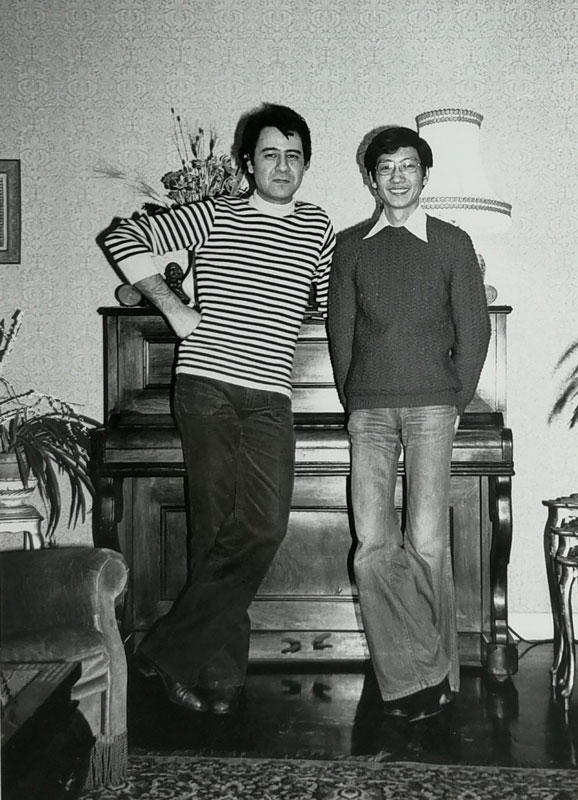
Lau Po Shin with Henri Bernard Thiébaud
Certificate of Attestation of completion of the training course at the Workshop of engraving of mint in June 1978:
The medal workshop at the Academy of Fine Arts. 1976 to 1978.
The Academy of Fine Arts of Paris in France is located next to the magnificent Seine. Not far from the French Academy and across the river is the famous Louvre Museum. From the Monnaie de Paris, along the river, it takes about 10 minutes on foot to get to the Academy of Fine Arts. I learned the techniques on the use of the engraving knife and the basic techniques of engraving in the engraving workshop of the Monnaie de Paris. The master engraver Mr. Émile Rousseau contacted Professor Raymond Corbin of the Academy of Fine Arts in Paris, because I had to go to his workshop to learn the techniques of bas-relief and sculpture. I wanted to acquire a solid foundation for the techniques of etching. There was also a young Frenchman, named Dominique Simon, who had just arrived in the medal workshop. So we meet every morning and have lessons together. Shortly after, he stopped pursuing his studies. Every morning, I continued to go to the Academy of Fine Arts to take my classes. After a year of apprenticeship, I had completed my bas-relief sculpture lessons. At noon, I would return to the canteen of the Monnaie de Paris to have dinner with engravers and I would go to work in the engraving workshop in the afternoon.
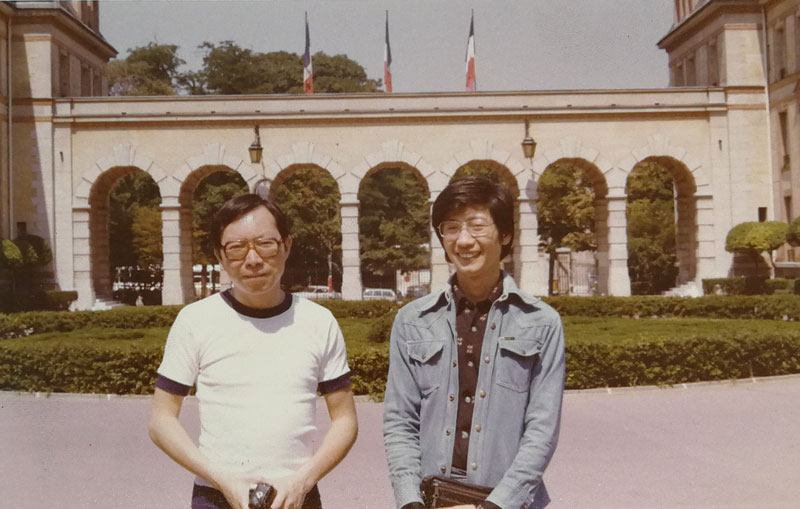

At that time, when I met Professor Corbin, he was 70 years old. He was a very nice old French man with short white hair. He spoke to me with a smile, and maybe because he drank alcohol a lot, he always had a reddish complexion. The workshop was a very ordinary workshop with a lot of light. On the model scene, there were always nude models arranged by the school. There weren’t many students here, about ten. The teachers came twice a week, and we have to concentrate on our learning. Whenever the teacher came, he looked at my bas-relief works, helped me edit them, and was sometimes critical of my designs. The Monnaie de Paris does not easily agree to publish his new works. It’s a shame that all my sculptures and bas-reliefs made at the Academy of Fine Arts in Paris were scrapped during my many moves and during my immigration.
Certificate of studies at the Academy of Fine Arts in France 1978 in French and English translation:
Some French students needed to worry about their own financial issues, so they didn’t come to class every day. A French classmate, a student from another province, very kindly invited me to dinner at her place. In the wooden house covered with aluminum, there was no heating. The temperature was below zero in winter. She had a cold that day. Despite the fatigue, she was very optimistic. I admire her very much, a simple knot made by a red ribbon made her very beautiful, very fashionable and very sunny. As the teacher did not come to teach every day, I would ask my classmates to teach me technical knowledge. In fact, my steel engraving technique was completely learned at the Monnaie de Paris. At the end of the semester, I used the trial version of the factory-engraved “Wild Goat” medal as the final work of my academic record. He was very satisfied. He wrote a certificate to demonstrate the completion of my apprenticeship. At the same time, he gave me one of his medals as a souvenir. I know he likes wine, so I went to a Chinese grocery store and bought alcohol such as Chinese Shaoxing Hua Diao rice wine and fragrant osmanthus wine. Before the end of the course, I invited him to drink with my classmates and the models, so that they could try the wines from China. I gave my farewells and thanked them for their help.
Pictures of the departure celebration of Lau Po Shin at the Monnaie de Paris in 1978:
Raymond Corbin (1907-2002) is a famous engraver and a master of art. The following picture is the gift I received from him, the work of Professor Corbin, “75th anniversary of the French School of the Far East”. In the front is a bird in the myth, in EFEO (abbreviation of the French School of the Far East), there is an Indian in the midst of ornamentation, 1901-1976. The reverse side is based on the work “Turtle and Snake” by Wu Daozi, a painter from the Tang Dynasty, (this artwork is in the British Museum 39 1/2 “x 20 3/4”). Also in French 75th Anniversary The French School of the Far East and two ancient Chinese inscriptions in oracle bone “Dongfeng”.
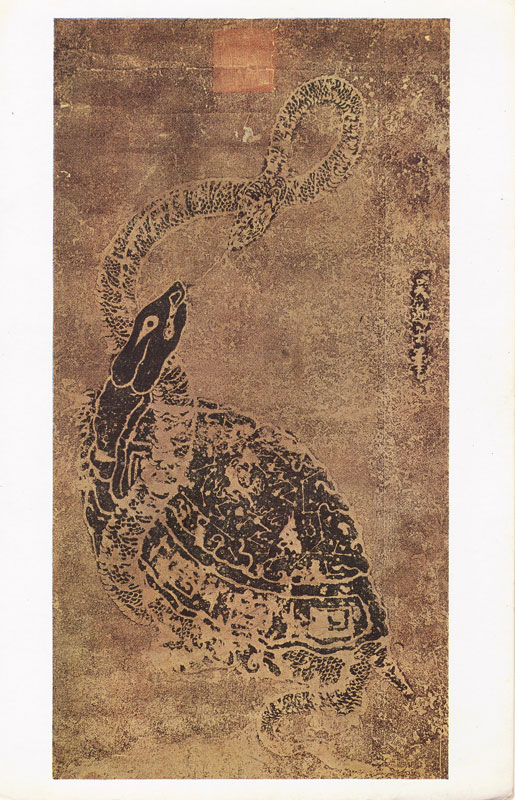
Postcard of the artwork Snake and Tortoise from the British Museum. 
Medals of Lau Po Shin at the Monnaie de Paris
Medal Le Panda by Lau Po Shin in 1978 at the Monnaie de Paris:
Medal Le Palais Impérial de Pékin by Lau Po Shin in 1979 at the Monnaie de Paris:
Medal Zu Chong Zhi, Mathématicien by Lau Po Shin in 1979 at the Monnaie de Paris:
Editing decisions of the medals Le Panda, Le Palais Impérial de Pékin and Zu Chong Zhi, Mathématicien by Lau Po Shin at the Monnaie de Paris in 1978 and 1979:
Publications of Lau Po Shin’s Medals
Presentation of the medal Le Panda by Lau Po Shin in the Catalogue Général Illustré des Éditions de la Monnaie de Paris 4**/ De 1945 à nos jours (E-O):
Presentation of the medal Palais Impérial de Pékin by Lau Po Shin in the magazine …Et La Pierre Devint Metal in 1989/C-50F:
Presentation of the medal Zu Chong Zhi by Lau Po Shin in the catalogue Le Club Français de la Médaille number 66/67 first trimester 1980:
Presentation of the medal Le Panda by Lau Po Shin in the catalogue Les Éditions Récentes de la Monnaie de Paris June 1982:
Presentation of Lau Po Shin in the magazine Paroles April 1983 of Alliance Française de Hong Kong:
Presentation of Lau Po Shin in Chinese Newspapers of Hong Kong in 1980:


